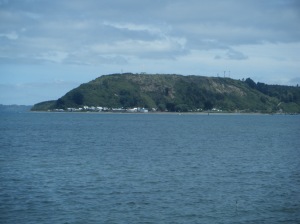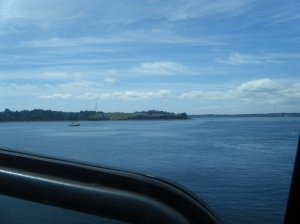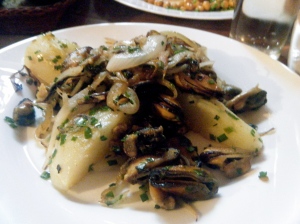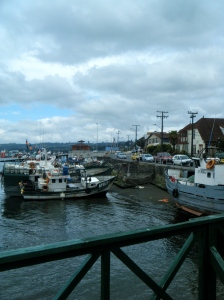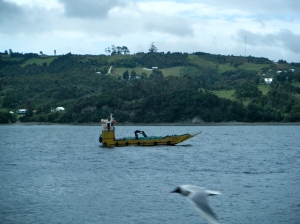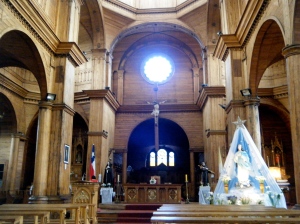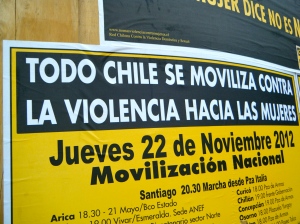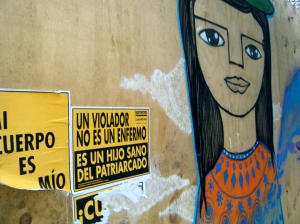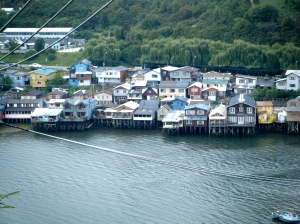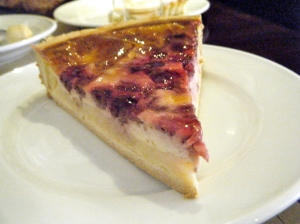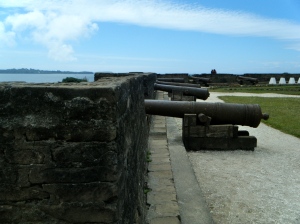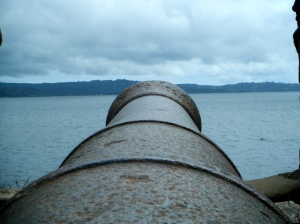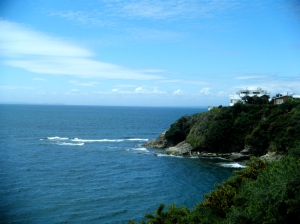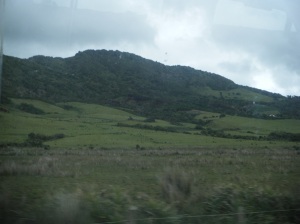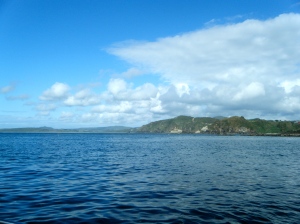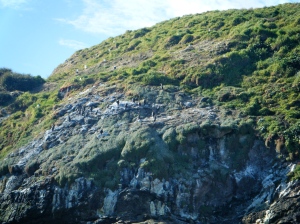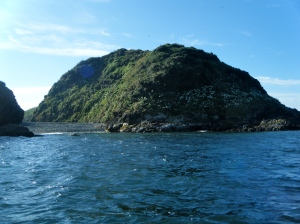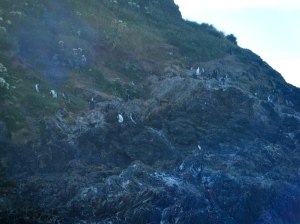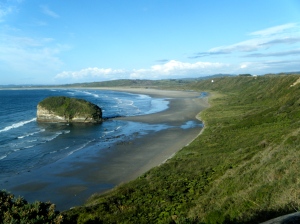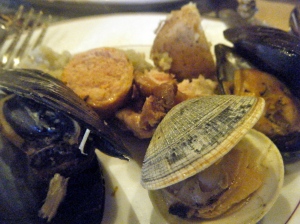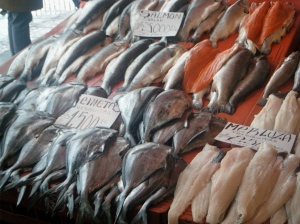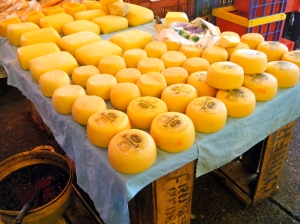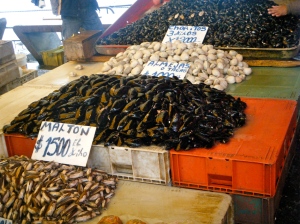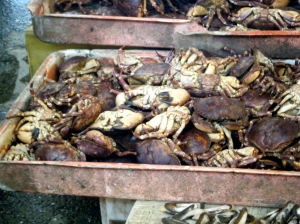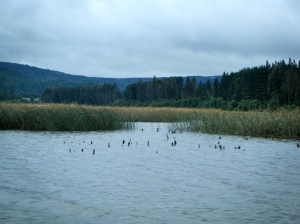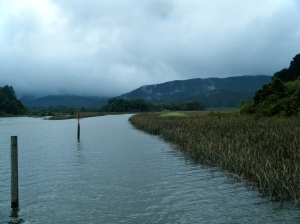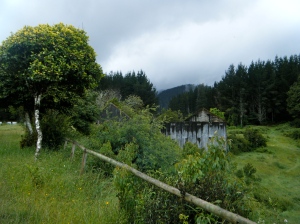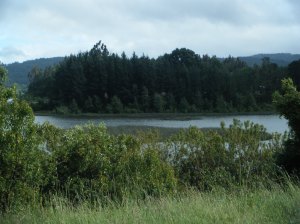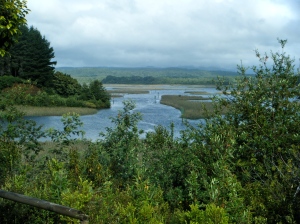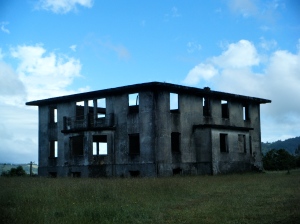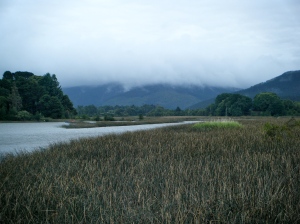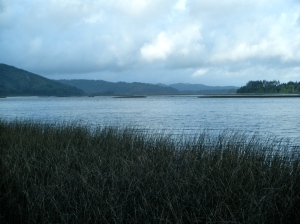They say if you really want to experience Chile, you need to go south.
And so we did.
It was pretty whirlwind to be honest. My travel companion, my dear friend F., and I bought bus tickets and made hostel reservations on Tuesday morning. I spent the rest of the day packing. We went to see my host sister’s play that night, ran home to grab our bags and eat a sandwich, and just barely got off the metro in time to catch the bus.
We started off by taking an overnight bus to Puerto Montt. Listen, kids: ask the locals and get recommendations. We asked our Chilean families and friends where we should go and what we should see. The consensus on Puerto Montt was that we only needed half a day there. And were they right. We arrived, bought our next set of bus tickets for Chiloé, and then wandered around the city for a while to have lunch.
Puerto Montt is a major transportation hub. It’s a great place to start your trip south, but beyond that, there’s not much to see. The only thing we did “miss” was Angelmó, a major fish and artisan craft market, but those kinds of places are found in pretty much every city in the south. Puerto Varas is just a half an hour away, and from there you can get some great outdoor excursions to the lakes and the volcanoes. However, I think that there is ample lodging available in Puerto Varas, meaning that you don’t even need to make a stop in Puerto Montt unless you really need a more urban base.
Things we learned in Puerto Montt: the major bus stations here are more like airports, with lots of clear signage, clean(ish) bathrooms, and sufficient dining options. Also, they were ready for the holidays in that bus terminal:
Also, we were reminded that in general, Chile looks nicer in the sunlight. I suppose you could say that about a lot of places, but I do believe that there are cities in the world which still hold their charm if it is cloudy and gray. I have yet to experience that in Chile. Without the sunlight, you can’t obscure the characteristic dirt and grime of Chile’s cities (this includes parts of Santiago). But in the sunlight, everything is much more vibrant and cheerier.
After a nice lunch in a German-inspired café recommended by my guidebook, we got on another bus and headed three hours south across the Chacao channel and down Ruta 5 to Castro, the largest city on the island of Chiloé. Chiloé is known for harboring a more traditional way of life. Things move more slowly down there. The communities are smaller, people are friendlier (although less polite? That was our experience, anyways.), and life in general is just quieter. Even the weather was different- we were further south enough that the daylight hours were longer, but the weather was still substantially cooler and wetter. But more on that later.
To get to Castro, we had to cross a channel, and to do that, our bus got on a boat. Yup, we were on a bus on a boat. I didn’t know that they made ferries large enough to carry semi-trucks and buses with full cargo. We didn’t even have to get off the bus! They just turned it off as we made our way across the water.
The buses that go around Chiloé serve as long-distance and short-distance or intercomunal buses. What this means is that our bus driver had all of us on board who had already paid for tickets and got on at the bus terminal, but on the way, we stopped at various bus stops on the side of the highway and picked up more passengers, dropping them off pretty much wherever they asked. This echoes other things we’ve learned about Chile, like their disinterest in forming lines. Someone will pick you up. You’ll get where you need to go. No problem. Just take it easy; someone will help you out! Although it was a little annoying when suddenly the bus filled up like a Santiago micro during rush hour, it was another demonstration of the buena onda (good will) of Chileans: it’s just no big deal for a big bus to stop on the side of the road and pick up more passengers, and drop them off wherever.
And another thing about the buses: it seems like there are always three people in the front. One is the driver, the other is the steward, and the third seems to be a friend, the steward’s kid, someone who does not work for the bus company. Again, no big deal. Everybody’s welcome!
We finally arrived in Castro late in the afternoon. We went to our hostel to drop off our bags and get a recommendation for dinner. Once again: trust the locals. Ask the locals. Especially trust your hostel owners and staff! Their business is to give you a nice place to stay and to help you enjoy the city. The girl who checked us in- and really, she was in a school uniform and hanging out with friends. Couldn’t have been older than 16.- gave us a very nice tourist map and recommended a place for dinner. Although we were a little skeptical of her suggestions, given that she was 16 and had the keys to our room mixed up with the keys to the house, we decided to give it a shot, since we had nothing else really to go off of. And boy, was it a good deal! For about $5 each, my friend and I got an appetizer, salad, an entree, a beverage, and dessert. These were high quality meals as well- fresh tomato soup; smoked salmon with ricotta and herbs; braised beef with sautéed garbanzo beans; sautéed mussels with potatoes and onions; and fresh peaches with honey and cinnamon. For $5 each. You couldn’t get that for $10 in the States, nor in Santiago.
And this is what the sunset looks like from the streets of Castro.
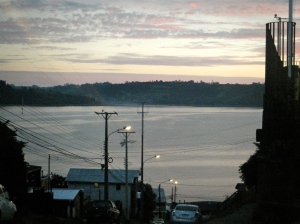
After this picture, we hustled our way home with pepper spray at the ready, because it seemed like all the women of Castro disappeared from the streets, and the only people left were men who were fascinated by our blonde hair.
We woke up early the next morning and chatted for a few minutes with our hostel owner- the real owner, not the 16-year-old girl. He served us a great breakfast that included smoothies and Colombian coffee (not Nescafé!), and suggested that we take a minibus over to the village of Dalcahue, where we could see a prettier, more typical side of Chiloé. It was a great recommendation. We saw a nice, small artisanal market, selling mostly woollen goods, and got another cheap but delicious lunch.

Across the way was another island, where we could have seen an even smaller and more typical village.
We also went to a wooden church, which is typical of Chiloé. These churches are found in every village and have been around for years. Many of them are UNESCO World Heritage sites, including this one in Dalcahue, Nuestra Señora de los Dolores (Our Lady of Sorrows).
Later that day we explored downtown Castro, and visited their own church, San Francisco, which I believe is the largest of the Chilote churches. This was a truly impressive and beautiful building. It felt like we were inside a big old ship.

The church is currently going under reservation. We’re pretty sure these aren’t the original colors.
There are various shrines inside the church, and all around the shrines, the faithful leave petitions and memorials. It is very powerful to read other people’s prayers. Many of them asked for healing or the safety of a loved one. Many others gave thanks for petitions granted. I feel that in the States, Catholics are a little more private about their prayer. You don’t necessarily see prayers written and displayed for everyone to see lining the walls of the church. But in many places here, everyone can see, which also means that people can join you in your prayers.
All around the outside of the construction were these posters protesting violence against women. I found the church to be a very interesting and powerful location for the ads.
Castro is also known for its palafitos, houses which are built up on stilts over the water. There are actually a couple of hostels housed in palafitos, but they were pretty expensive. Castro has several good lookout points to photograph the palafitos.
We also stopped into a quiet little coffee shop for onces. I had kuchen, a German kind of cheesecake. Kuchen can be found in pretty much every bakery and coffee shop in the south. That reflects the strong German influence on the culture. At times, it felt like my hometown, where the majority of the population claims German heritage, and the city reflects that.
The next day we packed up and headed off to Ancud. I don’t think we really missed out on anything happening in Castro. The only other thing we could have down in Castro would have been to make a trek out to Parque Nacional Chiloé, but since neither F. nor I wanted a particularly exerting trip requiring gear, we decided to pass.
Ancud is an hour and a half north of Castro. It’s quite a bit smaller population-wise and seems less urban, although, as we learned, it’s more spread out. We arrived before noon, with plenty of time to talk with the hostel owner, who recommended us a very cheap lunch ($3 for salad, soup, entree, side, juice, bread, and dessert) and drew up a walking tour of Ancud. Ancud is very quiet and quaint, prettier than Castro in my opinion, but definitely with less to do.
Here are some of the photos I got on our walking tour:
One of the stops on the walking tour was Fuerte San Antonio, the remnants of one of the Spanish forts.
The walking tour turned out to be longer than our hostel owner told us, so we found ourselves half running across Ancud to make it back in time to pick up the last penguin tour of the day. For about $30 we got picked up directly from the hostel and went to Las Pingueras, where several tour companies have founded an ecotourism collective which takes tourists out onto the water to visit four penguin colonies. After seeing the penguins, we had time to walk on the beach, and then we were taken up to a mirador (lookout) to take pictures of the beach below.
The first photo you see is actually of the landscape around us on the way out to the beach. This is South America, folks. It’s not all jungle or desert or beaches. A lot of it is very forest-y, with country familiar to us in the States. You just never know what you’ll find down here.
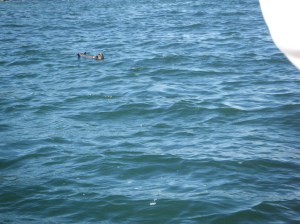
In the corner, you can see a little furry creature floating on its back. That’s a nutria- in English, a sea otter!
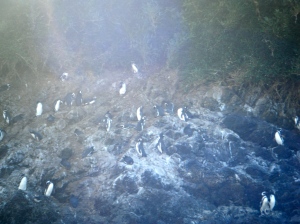
They have two kinds of penguins in the colonies, Humboldt and Magellanic. One of them has a white collar, the other doesn’t.
When we got back into town, we set off to try curanto. Curanto is a meat and seafood stew typical of Chiloé. If you go to Chiloé, you have to try curanto. We did so against my host dad’s recommendations. His worry was that we would pick any old place and they would just heat up a stew that they had made days ago, and we would get sick. Instead, we found a restaurant that came highly recommended in the guidebook, paid a little more and assured ourselves of the quality and safety of the dish.
Some places still serve the stew in its broth. Our meat and seafood, however, were taken out of the broth, and the broth was served separately. We ordered one plate, which the two of us couldn’t finish. Once again, it was a great deal.
The next day, we headed out in the morning for Valdivia, our last stop on this whirlwind adventure. Valdivia was a solid six hours from Ancud, including ferry time and various other stops along the way, so most of that day was spent traveling in the rain. The rain pretty much wouldn’t stop those last two days of the trip. It did make it a little difficult to take it easy and just enjoy walking around and exploring the city, but it was another Chile lesson: sometimes it rains, you’re gonna get wet, and you just have to deal with it.
The evening we arrived we went to a chocolate shop and had fancy coffee and ice cream. Then we proceeded to buy large amounts of chocolate which made repacking our bags difficult. We pretty much hung around the same street corner those couple of days, since we happened to spend our last day in Valdivia on a Sunday, when there really wasn’t much open. And again, it poured.
One of the things we did manage to do was walk around the Mercado Fluvial, their outdoor market on the river. If we had been staying a longer time, or if I lived there, I would buy fish and shellfish there all the time. I might just buy all of my food there all the time. Just look at all this freshness!
We killed time at lunch and in the indoor market, looking at more artisanal goods. While I acknowledge that these handicrafts take a lot of work and really are very beautiful, I can only look at so many wooden spoons, clay bowls, and wool sweaters before I start to get bored. However, it was dry and quiet in there, and I bought copper earrings, so it was a nice time.
Later in the afternoon, we went out on the river for a three hour tour (Gilligan’s Island? Anyone? Anyone?). Part of the tour took us to a nature reserve/sanctuary, where there were the remains of an old German estate. After that we visited the oldest church in Valdivia. Lesson: churches are history, people!
Here’s my last set of photos from this trip. Take it in. And maybe it will redefine your image of South America:
In spite of rain and not being able to sleep on buses, and men being excessively enthralled by blonde hair, it was a wonderful trip. Thank you, F., for being such a good travel buddy! I can be slightly neurotic and paranoid when I travel. I’m afraid to get lost. I’m afraid I’ll lose stuff. I’m afraid something bad will happen. But I want to take risks and have (small) adventures, which pushes me out into the world dealing with all those fears and contradictions. And you put up with all of that oh so well.
I have just about a week left. A week. I’ll be writing another post, maybe two, before I go. But still. About a week or so ago I was getting really really excited to go home and not thinking about leaving here yet. Going home and leaving here are two different things. And now that I’m back, I’m trying to listen to Christmas music and get in the holiday spirit, prepping myself for the return, and…it’s tough. A solid week is a lot of time to get a lot of stuff done if I do it right. I’ve had the semester I wanted to have. I’ve done what I wanted to do. Now it’s just time to wrap it up and put a big red bow on it.
Ya po, ¡vamos!
With love,
Gaby


